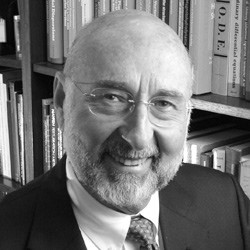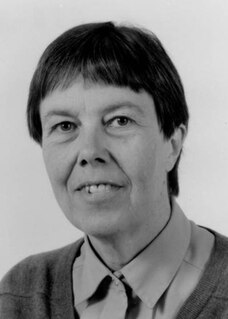
Sir Michael James Lighthill was a British applied mathematician, known for his pioneering work in the field of aeroacoustics and for writing the Lighthill report on artificial intelligence.

In fluid dynamics, vortex-induced vibrations (VIV) are motions induced on bodies interacting with an external fluid flow, produced by, or the motion producing, periodic irregularities on this flow.
Parviz Moin is a fluid dynamicist. He is the Franklin P. and Caroline M. Johnson Professor of Mechanical Engineering at Stanford University. Moin has been listed as an ISI Highly Cited author in engineering.

Harry Julian Allen, also known as Harvey Allen, was an aeronautical engineer and a Director of the NASA Ames Research Center, most noted for his "Blunt Body Theory" of atmospheric entry which permitted successful recovery of orbiting spacecraft. His technique is still used to this day.
William Reginald Dean (1896–1973) was a British applied mathematician and fluid dynamicist. His research interests included Stokes flow, solid mechanics, and flow in curved channels. The Dean number bears his name.

In fluid dynamics, Görtler vortices are secondary flows that appear in a boundary layer flow along a concave wall. If the boundary layer is thin compared to the radius of curvature of the wall, the pressure remains constant across the boundary layer. On the other hand, if the boundary layer thickness is comparable to the radius of curvature, the centrifugal action creates a pressure variation across the boundary layer. This leads to the centrifugal instability of the boundary layer and consequent formation of Görtler vortices.
Philip Geoffrey Saffman FRS was a mathematician and the Theodore von Kármán Professor of Applied Mathematics and Aeronautics at the California Institute of Technology.
John Leask Lumley was an American fluid dynamicist and a professor at Cornell University. He is widely known for his research in turbulence and is the coauthor of A First Course in Turbulence along with Hendrik Tennekes.
Leslie Gary Leal is the Warren & Katharine Schlinger Professor of Chemical Engineering at the University of California, Santa Barbara. He is known for his research work in the dynamics of complex fluids.

Stephen Howard Davis was an American applied mathematician working in the fields of fluid mechanics and materials science. Davis was the McCormick School Institute Professor and the Walter P. Murphy Professor of Applied Mathematics at Northwestern University. Davis has been listed as an ISI Highly Cited researcher in Engineering. His work was acknowledged in festschrifts in 2002.
John Wilder Miles was a research professor emeritus of applied mechanics and geophysics at Scripps Institution of Oceanography, University of California, San Diego. He was well regarded for his pioneering work in theoretical fluid mechanics, and made fundamental contributions to understanding how wind energy transfers to waves.
In fluid dynamics, wave–current interaction is the interaction between surface gravity waves and a mean flow. The interaction implies an exchange of energy, so after the start of the interaction both the waves and the mean flow are affected.

John Vrooman Wehausen was an American applied mathematician considered to be one of the world's leading researchers and pioneers in the field of marine hydrodynamics.

William Craig Reynolds was a fluid physicist and mechanical engineer who specialized in turbulent flow and computational fluid dynamics. He completed his undergraduate degrees, as well as his doctorate, all at Stanford University, in 1954, 1955, and 1957, respectively, after which he joined the faculty. He was chairman of the Mechanical Engineering Department from 1972 to 1982 and again from 1989 to 1992. Reynolds was one of the pioneers in Large eddy simulation for fluid modeling. He was elected to the National Academy of Engineering in 1979. He won the Fluid Engineering Award of the American Society of Mechanical Engineers in 1989 and the Otto Laporte Award by the American Physical Society in 1992.
Paul H Steen was an engineer and scientist. He held the Maxwell M. Upson Chair in Engineering at Cornell University. Steen received degrees in Engineering and English Literature from Brown University, his PhD from Johns Hopkins University, and postdoctoral training at Stanford University.

Susan North Brown was a professor of mathematics at University College London and a leading researcher in the field of fluid mechanics.

John Francis Brady is an American chemical engineer and the Chevron Professor of Chemical Engineering and Mechanical Engineering at the California Institute of Technology. He is a fluid mechanician and creator of the Stokesian dynamics method for simulating suspensions of spheres and ellipsoids in low Reynolds number flows. He is an elected fellow of the American Physical Society, a fellow of the Society of Rheology, as well as a member of the National Academy of Sciences, the National Academy of Engineering, and the American Academy of Arts and Sciences.
In fluid dynamics, the Craik–Leibovich (CL) vortex force describes a forcing of the mean flow through wave–current interaction, specifically between the Stokes drift velocity and the mean-flow vorticity. The CL vortex force is used to explain the generation of Langmuir circulations by an instability mechanism. The CL vortex-force mechanism was derived and studied by Sidney Leibovich and Alex D. D. Craik in the 1970s and 80s, in their studies of Langmuir circulations.
Ravindra Nath Sudan was an Indian-American electrical engineer and physicist who specialized in plasma physics. He was known for independently discovering the whistler instability in 1963, an instability which causes audible low-frequency radio waves to be emitted in the magnetosphere in the form of whistler waves. He also pioneered the study of the generation and propagation of intense ion beams, and contributed to theories of plasma instabilities and plasma turbulence.









